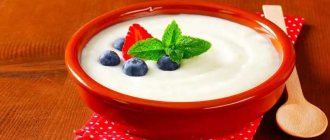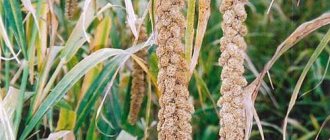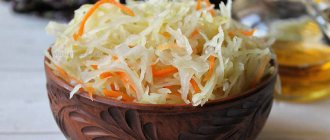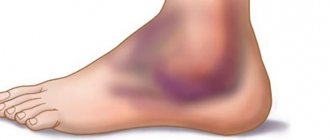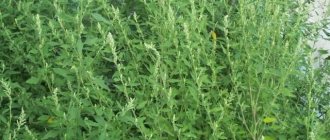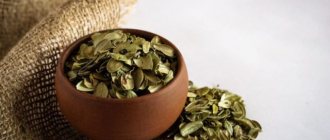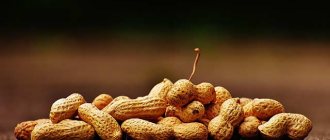There is probably no person who doesn’t know what buckwheat looks like and what it tastes like. We know about its benefits, but we don’t know that it turns brown after serious heat treatment, which is carried out to extend shelf life. It enters production green. Naturally, after processing it loses some of its beneficial properties, but this does not make it less useful.
| Calories per 100 g, (kcal): | 313 |
| Protein per 100 g, (g): | 12.6 |
| Fat per 100 g, (g): | 3.3 |
| Carbohydrates per 100 g, (g): | 62.1 |
| Glycemic index: | 40-55 |
Composition and calorie content of buckwheat
Compared to other cereals, buckwheat contains 3 times more nutrients and vitamins. These are vitamins B1, PP, A, B6, E and B9. Fats, for the most part, are polyunsaturated, that is, they help lower cholesterol and are well absorbed by the body. The protein contained in cereals contains many amino acids, so buckwheat can even be compared to low-calorie meat.
There are many micro and macroelements in the cereal composition. These are iodine, silicon, copper, nickel, tin, zinc, selenium and others. Cereals contain starch, ash and dietary fiber.
The calorie content of buckwheat is 310 kcal.
Chemical composition and nutritional value
So what substances is buckwheat rich in, why have people regularly been using it as food for several thousand years? Thanks to modern research, we know for sure that this cereal contains:
- vitamins of group B, A, E;
- calcium;
- iron;
- phosphorus;
- zinc;
- sulfur;
- fatty acid;
- citric and malic acid;
- fiber and many other microelements.
More than half (58%) of buckwheat consists of carbohydrates. It also contains proteins – 13%. But the fat in cereals is only 3%, and its calorie content is average - about 300 kcal per 100 grams.
Buckwheat beneficial properties, vitamins and minerals
Buckwheat is especially popular in dietary nutrition.
Porridge keeps you feeling full for a long time and does not contribute to weight gain. Raw buckwheat has particularly high health benefits. That is, you can not cook the cereal, but simply steam it and get the maximum amount of benefit from it.
Regular consumption of cereals helps improve the condition in the presence of the following problems:
- for liver disease;
- with atherosclerosis;
- for problems with bowel function;
- for constipation;
- for cardiac dysfunction.
Cereals promote protein synthesis due to the presence of manganese in its composition. It helps regulate the functioning of the thyroid gland and normalize the amount of insulin.
Buckwheat is useful for heartburn. Cereal flour helps to cope with boils and other skin diseases.
Beneficial features
Considering the composition of the cereal, it becomes clear that with its regular use you can achieve the following results:
- cleanse the body of toxins and waste;
- strengthen blood vessels;
- improve heart function;
- lower cholesterol levels;
- normalize blood glucose;
- increase immunity;
- reduce the risk of anemia;
- get enough protein and amino acids for normal functioning of the body;
- increase endurance;
- minimize the impact of stress.
What kind of buckwheat is there?
There are two types of cereals on sale: prodel (chaff) and kernels. The latter type is more suitable for preparing crumbly porridges and stuffing. Prodel is a chipped grain and is ideal for cereals and casseroles.
There is also green buckwheat on sale, which is essentially a raw, unfried product. It is this type that has the richest composition of nutrients and vitamins. It can be steamed, sprouted, it is quickly digested and is suitable for making pies and meatballs.
Smolensk buckwheat is a cereal with small kernels not exceeding 2 mm in size, white in color. It has the lowest fiber content, but a lot of starch. It is believed that this buckwheat is grown without the use of pesticides.
What is green buckwheat?
No, this is not a trendy superfood, although it is advertised as such. This is still the same buckwheat, but not roasted during production. Unlike fried, it is softer to the touch and absorbs water well, increasing in size several times when cooked.
On the one hand, such cereals are more useful, since 100% of the nutrients remain in it. On the other hand, it is more fragile and susceptible to mold and other microorganisms. If fried cereals can be stored for years, then the shelf life of green cereals is no more than 1–1.5 years.
Oat flakes Russian Product “Hercules Traditional”, 500 g 72 rub.
Oat flakes Russian Product “Hercules Monastyrsky”, 500 g 72 rub.
Rice Agro-Alliance Extra “Red Ruby”, 800 g 219 rub.
Nordic cereal “Chopped oats”, 500 g 200 rub.
Porridge Sweet season “Multi-grain with flax seeds”, 35 g -20%
9 rub. 11 rub.
Elovena Nordic “Gluten Free Oat” cereal, whole grain, large, 500 g -34%
146 rub. 220 rub.
Yelli soup “Siberian | With porcini mushrooms and pearl barley”, 125 g 169 rub.
Agro-Alliance Extra “Oat” bran, 400 g 69 rub.
Other healthy cereals on TEA.ru
The benefits of buckwheat for men
For the male body, the main benefit of cereal is that it contains a lot of protein and, to some extent, can even replace meat dishes. Even though it is a vegetable protein, it still has a positive effect on the endocrine system and the functioning of the gastrointestinal tract.
Scientists have found that dopamine, which buckwheat is rich in, helps cope with depression. Zinc and magnesium have a beneficial effect on the sexual sphere, improving potency. But to get the effect of cereals, porridge from it must be consumed regularly.
Buckwheat and buckwheat porridge - what is it?
Buckwheat consists of brown triangular grains, but oddly enough, the brown triangular grain we are accustomed to is the result of its roasting; in its normal state, buckwheat consists of green grains.
During flowering, the plant itself is covered with very beautiful white and pink flowers, which have a wonderful aroma. Buckwheat can be steamed, boiled or baked, served in soups, goulash or salads. It is one of the standard rice substitutes and is prepared using the same soaking methods as rice.
It is a favorite food product among many peoples of the world, but it is especially popular and loved among the Slavs, and India is called its homeland and there the grain was considered black rice. Buckwheat porridge is the result of cooking buckwheat.
Eating buckwheat during pregnancy
Buckwheat is one of the best foods that have a positive effect on the development of the fetus and the condition of the expectant mother.
It regulates blood pressure and improves the condition of vascular walls thanks to the presence of rutin. Buckwheat regulates the acid and salt balance in the body due to the presence of vitamin PP.
When consumed regularly during pregnancy, folic acid contained in cereals helps prevent anemia, which occurs in many pregnant women. The same acid reduces the risk of miscarriage and is involved in the proper formation of the baby’s nervous system.
Buckwheat helps remove “bad” cholesterol from the body and rids the intestines of putrefactive bacteria.
Tips and how to use it correctly
In order to obtain all the valuable properties of any product, it is necessary to select it correctly, store it, combine it with the right products, and also eat it correctly. Buckwheat was no exception.
Choosing buckwheat
When purchasing, you need to pay attention to the color and smell of buckwheat. If you smell mold, you certainly shouldn't buy it.
The color of good buckwheat should be light brown . If you see dark brown cereal, this may indicate that it has been subjected to heat treatment and has lost some of its valuable properties. The cereal in the package should not contain any other particles.
Storage
To preserve the beneficial properties, it is very important to follow the simplest storage rules and temperature conditions. Buckwheat is best stored covered and in a dry place for no more than a year. All this will help save it from mold and bugs getting into it. After purchasing cereal, it is best to move it into a closed container to prevent it from evaporating.
How to eat properly
Buckwheat can be eaten boiled, but it is most beneficial for our body if it is steamed. To prepare buckwheat in this version, you only need one glass of cereal, which needs to be rinsed, then poured with boiling water and left in a thermal container overnight. The end result is a very healthy porridge.
What to combine with
Since early childhood, we have known such a dish as buckwheat porridge with milk . But whether such a combination is useful is still debated by many scientists around the world. The fact is that buckwheat contains a lot of iron that is useful for our body, and the combination of this cereal with milk, according to some scientists, interferes with its absorption. If you or your child still can’t imagine buckwheat without milk, and also like to add sugar to it, then it’s better to use honey or berries.
Buckwheat goes well with vegetables, mushrooms and seafood. With their help, cereals most fully reveal all their valuable properties.
And of course, let's not forget about meat . It is certainly considered the best option for buckwheat porridge. However, scientists say that compounds contained in meat interfere with the absorption of iron. Therefore, it is better to diversify your diet and replace meat with fish or mushrooms.
Buckwheat consumption by children
Doctors never have any disputes about the benefits of buckwheat for a child’s body. All pediatricians are definitely in favor of children eating buckwheat porridge. It is a source of energy, increases hemoglobin and is perfectly absorbed by the body. Due to the presence of flavonoids, it improves blood clotting and regulates heart function.
The cereal is not an allergenic product as it does not contain gluten. The introduction of cereals is allowed from 5 months. You can cook porridge with milk only from 8 months.
Solving excess weight problems and benefits for pregnant women
Any nutritionist will nod his head approvingly when he learns that a person consumes buckwheat in the morning. The content of complex carbohydrates will provide the necessary supply of energy, which will allow you to avoid resorting to unhealthy quick snacks for at least several hours.
People who have set themselves the goal of quickly defeating the hated extra pounds rarely do without a kernel. Buckwheat with kefir is ideal for weight loss. This is a clear demonstration of the double detox effect in action. The buckwheat mono-diet allows you to significantly lose weight in a week, while avoiding the lack of nutrients.
How is it useful during pregnancy?
Buckwheat dishes are equally beneficial for pregnant women and nursing mothers. While carrying a child, the body experiences a double load, which often causes anemia. A similar problem often arises during lactation. Then buckwheat, rich in iron and folic acid, comes to the rescue, allowing you to compensate for the deficiency of these elements. Moreover, the latter forms the baby’s nervous system even before the child is born.
Buckwheat is equally effective in solving the problem of weight gain in all women, but this is especially important for pregnant women. After all, excess weight not only affects the general well-being of a pregnant woman, but can also become a serious problem during childbirth. In addition, consuming buckwheat porridge, which by and large does not have any specific odors or irritating taste characteristics, makes it possible to calmly survive the manifestations of toxicosis.
Child’s diet: pros and cons of buckwheat porridge
Buckwheat is undoubtedly useful for children as a source of balanced proteins, slow carbohydrates and easily digestible fiber. In addition, it is considered a hypoallergenic product. Individual intolerance to buckwheat in children is a rather rare phenomenon. After all, buckwheat is not a cereal, but a flower grain, so it does not contain complex protein. Namely, gluten or gluten, as already mentioned, can cause allergies.
Pediatricians advise introducing buckwheat porridge into the diet of babies starting at seven months. Its rich composition and nutritional value are an indispensable combination for a growing organism. The 10% dietary fiber content in buckwheat improves intestinal motility, contributing to the normal functioning of the entire gastrointestinal tract. Nutrients and vitamins are the key to rapid growth, full development, and a strong immune system. If the child is predisposed to asthma, the saturation of cereals with magnesium and vitamin E can reduce the risk of this disease.
Buckwheat porridge diet
There is no doubt that a strict diet based on the consumption of buckwheat will be effective, but after it ends it will be much more difficult to maintain the result. For strict diets, steamed cereal is used, without adding salt, oil or any other components. It is permissible to consume only kefir, but not more than 1 liter per day. You will also need to drink a lot of water. The course should not exceed 7 days in a row. You need to eat buckwheat at least 6 times a day.
You can also do fasting days on buckwheat. On such days, you must adhere to the same rules that are provided for the classic method of losing weight on buckwheat.
Buckwheat for weight loss
There is no point in exhausting yourself with strict diets in order to gain a beautiful figure and get rid of excess weight. An excellent option for unloading would be a buckwheat diet. The diet will not only burn extra calories, but also provide the body with useful microelements, vitamins, acids, etc. Buckwheat allows you to make the menu balanced and does not cause harm. To maximize the benefits, you need to follow the rules:
The diet should include cottage cheese, low-fat kefir, white meat, fish, eggs (in small quantities). You can also eat fruits, vegetables, berries.
Important: when dieting, you need to completely eliminate sugar, fats (animals), white bread, and reduce the amount of salt. At the same time, increase the amount of water consumed - 2 liters per day.
As dishes you can eat porridge with water and with vegetable oil, soups with buckwheat and vegetables.
Buckwheat on the water
Rinse the cereal and pour boiling water over it and wrap it, in the morning add green fruits, butter and eat. If desired, you can add a teaspoon of honey, drops of lemon juice, citrus fruits, etc. The course can last a week, then take a break of 3-4 days and repeat again.
Buckwheat on kefir
This diet can be maintained for 10 days. The requirements are the same as in the first recipe. Cereals for consumption are prepared quickly: pour half a liter of low-fat kefir, put them in the refrigerator (preferably in the refrigerator). The next morning the porridge will swell and be ready to eat.
The use of buckwheat in cosmetology
Buckwheat is an excellent base for preparing cosmetic masks at home. It is especially useful after 40 years.
The simplest recipe based on cereals for wrinkles:
- 15 g porridge;
- egg yolk;
- almond oil, 20 drops.
The crumbly porridge is mixed with the rest of the ingredients and applied in a thick layer to the steamed face. After 30 minutes, the mask is washed off with warm, running water.
This mask significantly rejuvenates and makes facial skin more elastic.
Harm and contraindications of buckwheat
When talking about the properties of products, it should be remembered that benefits and harm to the body are inseparable factors, and there are restrictions on the use of products even with their most positive characteristics. The same applies to buckwheat. Before eating it, remember the following:
- It is not recommended to give buckwheat to children often or in large quantities. If you want or need to increase the dosage, you need to monitor the body's reaction to avoid deterioration.
- Hard-cooked porridge can cause constipation and the reactions that occur in the body during the digestion of buckwheat lead to the formation of gases.
- Diabetics and people with chronic renal failure should eat buckwheat with caution.
- The duration of the buckwheat mono diet (when only one product is consumed) should be no more than 4-5 days.
Despite these restrictions, buckwheat should not be completely excluded from the diet for fear of complications. While maintaining common sense in eating, its beneficial properties quantitatively and qualitatively exceed the probable harm.
Is buckwheat equally beneficial for everyone?
Buckwheat in any form improves health and brings invaluable benefits. Its use has a positive effect on digestion, metabolism, vascular function, heart function, etc.
If we talk only about the male body, then its inclusion in the diet:
- normalizes the psycho-emotional background;
- stimulates the production of the pleasure hormone (dopamine);
- improves potency and increases libido.
Eating buckwheat also has a positive effect on women’s health:
- Promotes weight loss.
- Regulates the functioning of the endocrine glands, as well as the reproductive organs. Eliminates hormonal imbalance. Women who regularly consume buckwheat experience PMS and menopause more easily.
- Prevents anemia, which is more useful and important for pregnant women.
- Prevents vitamin deficiency and postpartum depression.
- Regulates sudden surges in blood glucose.
- Improves the condition of hair, skin and nails.
Buckwheat is recommended to be introduced into complementary foods from 6 months. From infancy, it has a positive effect on the development of the child and the body as a whole:
- Strengthens the immune system. This is due to the rutin contained in buckwheat, which enhances the effects of vitamin C.
- Promotes proper development of the muscular system.
- Improves digestion.
- Prevents anemia.
Who is buckwheat contraindicated for?
Buckwheat is not recommended for use if:
- individual intolerance – provokes allergic reactions;
- increased blood clotting - vitamin P in cereals will aggravate the condition.
Excessive consumption of buckwheat may result in:
- sensitivity to cold;
- tingling or numbness in the hands;
- inflammation of the skin in areas exposed to direct sunlight.
Application
Buckwheat is not only a nutritious and healthy porridge. Thanks to the beneficial substances it contains, cereals are also used as a medicine.
In cooking
Buckwheat is great for feeding children and adults. Dishes prepared from buckwheat are served as a side dish or an independent treat (from breakfast cereals to desserts made from buckwheat flour):
- from the kernel we get the crumbly porridge we are used to;
- done, the chaff cooks quickly and is ideal for baby food;
- Smolensk grain is often used to prepare casseroles, as well as fillings for pies;
- flakes are used for instant porridges and baking dietary cereal breads;
- buckwheat flour is used to make noodles, bake bread, pancakes, buns, etc.;
- Green buckwheat is eaten raw or sprouted, adding to salads.
In folk medicine
Buckwheat is also often used in folk medicine.
There are effective recipes based on it:
- Crushed buckwheat leaves or buckwheat flour are used to treat boils, purulent wounds, etc.
- With the help of juice from the leaves they fight conjunctivitis.
- Buckwheat honey copes well with colds and gastrointestinal problems.
- Buckwheat flowers and leaves are also suitable for the treatment of measles, scarlet fever, diseases of the upper respiratory tract, for strengthening the walls of blood vessels, and healing wounds.
- To cope with heartburn, just chew a few buckwheat kernels.
- Pillows are stuffed with husks and are recommended for use for insomnia and osteochondrosis.
For weight loss
Buckwheat is an effective aid in losing weight. The compounds included in its composition contribute to weight loss and cleansing of the body:
- fiber removes waste and toxins from the intestines, improves digestion, creates a feeling of satiety;
- organic acids do not allow carbohydrates and lipids to be deposited as fat reserves;
- complex carbohydrates take a long time to digest and prolong the saturation of the body;
- vitamins normalize metabolism;
- minerals remove toxins, excess fluid, optimize blood sugar levels.
The health benefits and harms of buckwheat from the point of view of experts
Regardless of the cooking method, the cereal retains its medicinal properties. Therefore, it is often boiled, simmered in the oven/low heat, or steamed. The porridge is also poured with water or kefir overnight. The next morning, the kernels swell and taste no different from the boiled version. However, not everyone likes this dish. To fix this, you need to find out a few more details about how buckwheat is beneficial for the body. And again we need to return to its composition.
A special place in it is given to 3 flavonoids (antioxidants):
- Quercetin. Necessary for the prevention of cancer. In addition, the connection makes the walls of the vessels strong, and also cleanses them of toxins and other formations.
- Vitexin. Gives blood vessels a more elastic structure and is responsible for their expansion. This flavonoid plays a key role in the enzymatic metabolism of the heart muscle.
- Rutin. It has a strengthening effect on the vascular system, especially in combination with vitamin C. For this reason, it is extremely necessary for patients in the postoperative period. The compound also increases the body's resistance to dangerous infections.
As researchers note, the health benefits and harms of buckwheat depend on the characteristics of each individual person. With potassium deficiency, patients' water-salt balance is disturbed. Iron deficiency is accompanied by oxygen starvation, which can lead to anemia. However, buckwheat contains up to 38% iron and 15% potassium. In this regard, regular use of this product normalizes the level of hemoglobin in the blood.
Note for those who are gluten intolerant. Unlike all other cereals, buckwheat does not contain gluten. Therefore, it is a unique analogue of barley, wheat, rye, and oats.
Buckwheat porridge is a faithful “companion” of men
100 g of this cereal contains up to 12 g of protein, which is of plant origin. This organic substance normalizes the activity of the nervous and endocrine systems. Thanks to this stabilization of metabolism in the body, many were able to lose excess weight in the shortest possible time. This is also due to the high digestibility of the cereal - up to 80%.
Moreover, the benefits of buckwheat for men can be seen in its ability to restore reproductive abilities. Scientists have studied that zinc, magnesium and other microelements contained in cereals improve potency. However, to achieve the desired result, you must adhere to an appropriate diet. In addition, not every type of cereal is suitable for such a task. In most cases, manufacturers of these food products produce low-quality products.
What else is buckwheat porridge good for? According to statistics, more and more men are suffering from depression. To get out of a depressed state, the hormone dopamine is needed. Regular consumption of this porridge contributes to its sufficient production.
Himalayan black porridge, or the benefits of buckwheat
About buckwheat - a simple but valuable product
Among the ancient Slavs, buckwheat porridge was considered the food of heroes, and it was brought to Rus' from Greece. The homeland of buckwheat is considered to be the highlands of the Himalayas, where its wild species still grow. It’s interesting that they began to call it “buckwheat” only in Rus'. This name comes from the “supplying country” - Greece, but in Western Europe (Portugal, Spain and France) it was called Arab or Saracen grain.
The Germans called buckwheat “pagan” grain, the Finns called it Tatar grain, and the Italians and the Greeks themselves called it Turkish grain. In Asian countries, Indians gave buckwheat the name “black rice”, some countries - “black wheat”, Western Slavs - Slovaks and Czechs - call it toadstool.
Around the 10th century, “black porridge” made from buckwheat became a favorite dish in Rus'. By the way, our ancestors called it “black porridge” because of their contemptuous attitude, since they believed that it was the food of common people. If the aristocrats had realized how much benefit there was in unsightly-looking cereals, they would hardly have so frivolously excluded it from their diet.
Now much is known about its benefits. But some properties of buckwheat made it especially popular in the harsh conditions of our climate:
- the plant is undemanding to growing conditions. Can grow on infertile soils;
- is not afraid of weeds, but on the contrary, successfully displaces them from the field; excellent green manure - a natural fertilizer for future crops;
- the crop does not require fertilizers or chemicals;
It should also be noted that due to its resistance to weeds and high natural yield, buckwheat does not require genetic modifications, so you can be sure of the natural origin of buckwheat.
Tasty and filling buckwheat is good both on its own and as a side dish. Steamed, without additives or steamed in boiling water, it is the basis of many diets; crumbly buckwheat porridge with butter satisfies well, and natural green buckwheat is a storehouse of useful elements. Honey, unique in properties and taste, is collected from buckwheat, and buckwheat husks are used to stuff environmentally friendly pillows. A traditional Russian product, buckwheat is still popular due to its many beneficial properties for our body.
Buckwheat is widely used in dietary and baby food.
The benefits of buckwheat
First of all, buckwheat is very rich in iron. In addition, buckwheat contains useful elements such as potassium, necessary for the functioning of the heart, calcium and phosphorus, essential for the skeletal system. This product also contains iodine, which has a multifaceted effect on growth, development and metabolism, zinc, which ensures the metabolism of vitamin E, fluorine, an essential element for tooth enamel, molybdenum, which is necessary to maintain the activity of certain enzymes, and cobalt, which is necessary for hematopoiesis and functioning. nervous system and liver. Buckwheat is also rich in vitamins: B1 (thiamine), which plays an important role in carbohydrate, protein and fat metabolism, B2 (riboflafin), necessary for the formation of red blood cells, for the regulation of growth and reproductive functions in the body, B9 (folic acid), indispensable for the creation and maintaining new cells in a healthy state, therefore the presence of a sufficient amount of this vitamin is especially important during periods of rapid development of the body - at the stage of early intrauterine development and in early childhood. In addition, vitamin PP (nicotinic acid), which is involved in fat metabolism, and vitamin E, which is an important antioxidant and helps enrich the blood with oxygen. Buckwheat also contains valuable proteins.
Buckwheat is high in calories; 100 grams of cereal contains more than 12 grams of protein and 62 grams of carbohydrates, which corresponds to 313 kilocalories. Vegetable protein is absorbed by almost 80%, and the carbohydrates in buckwheat are healthy slow carbohydrates, so after a bowl of buckwheat porridge you don’t feel like eating for a long time.
This cereal, for its beneficial properties
, especially recommended:
- pregnant and lactating women;
- children;
- athletes, people engaged in physical labor;
- elderly;
- convalescents, hypotensive patients, anemic patients, allergy sufferers, as well as persons with other diseases.
The balanced vitamin and mineral composition of the product makes it a unique remedy for many ailments. It is believed that buckwheat can increase hemoglobin in the blood, strengthen bones and joints, remove toxins, and cleanse the liver. But she is able to “work” not only from the inside!
- masks made from boiled porridge nourish the skin and help with excessive dryness and oiliness;
- finely ground cereal mixed with sour cream - a means for light exfoliation;
- buckwheat heated in a frying pan and poured into a linen bag warms up the chest well during bronchitis;
- sorting through cereals perfectly develops fine motor skills and is recommended for children.
And now about what buckwheat doesn’t contain.
Buckwheat contains practically no fast carbohydrates, making it indispensable in the diet of patients with diabetes and suitable for those wishing to lose weight. The main difference between buckwheat is that it is a grain of a flower, and not a cereal crop, like cereals. Because buckwheat is a non-grain, it does not contain gluten, the glue-like protein in wheat that causes food allergies in some people.
Buckwheat grains are triangular, covered with a dense shell - husk. The threshed grain has a delicate greenish color, but such buckwheat cannot be stored for long, so it is steamed or fried. This is how the cereal acquires a brownish tint and a special aroma. Thus, buckwheat, familiar to everyone since childhood, is a roasted grain. Recently, natural, unfried green buckwheat has become increasingly popular, because it retains much more vitamins and nutrients.
What types of buckwheat can be found on store shelves?
- Yadritsa
is a whole grain cereal. The larger the kernel, the more expensive it is. Widely used in cooking for porridges, side dishes, and other dishes. - Made, chopped
- chopped kernels. It costs less, cooks faster, but does not last as long. - Smolensk grits
- finer. Ideal for preparing viscous porridge. - Flakes
- obtained from whole grains that have been flattened and steamed. They cook quickly, but the nutritional value is lower than that of the core. - Flour
is ground grain. Bread from buckwheat flour alone will not work, since it is poor in gluten. But the pancakes and pancakes made from it are excellent. Instant baby porridge is also made from buckwheat flour. - Green buckwheat
- unprocessed kernels. A storehouse of useful substances, vitamins, microelements, an organically pure product. Used for diets, healthy eating, sprouting.
Thanks to its amazing chemical composition, buckwheat is able to remove cholesterol from the human body, cleanse the liver, stimulate cerebral circulation, strengthen blood vessels and the immune system. Considering all of the listed wonderful properties of buckwheat, it can be recommended for nutrition by everyone - from infants to the elderly.
To replenish the body's need for essential amino acids, it is not at all necessary to eat meat and dairy products, as is imposed by traditional medicine.
To do this, you can eat green buckwheat, which contains all 8 essential amino acids in very significant quantities, and most importantly, they are balanced and easily digestible, which cannot be said about products of animal origin.
See for yourself: Of the 20 amino acids contained in food proteins, 8 are essential. These are tryptophan, lysine, methionine, valine, threonine, leucine, isoleucine, phenylalanine. Three amino acids are most often deficient in diets: tryptophan, lysine and methionine.
Buckwheat contains (mg per 100 g of product):
- Tryptophan – 180
- Lysine – 630
- Methionine – 260
- Valin – 590
- Threonine – 500
- Leucine – 680
- Isoleucine – 520
- Phenylalanine – 540
- Histidine – 300
In terms of the content of essential amino acids from plant products, buckwheat is surpassed only by legumes, such as peas, soybeans and beans, but they are significantly inferior to it in ease of digestion and taste. Buckwheat confidently outperforms all cereals.
In the cuisines of various nations of the world you can find dishes prepared from buckwheat. True, in the form of classic porridge, to which many of us have become accustomed since childhood, it is consumed, perhaps, only in Russian, Ukrainian and Belarusian cuisine. But the Japanese, Italians and French love a variety of types of noodles, pancakes and pancakes made from buckwheat flour.
How to cook different buckwheat?
The kernel can be boiled in water or steamed. The latter method allows you to retain more nutrients in the dish. When cooking kernels, you need to take two measures of water for one measure of cereal.
Before cooking, the cereal should be sorted from unopened grains and debris, and rinsed until clean. For a more pronounced taste, buckwheat can be calcined without oil. Then add water, boil, skim off the foam, add salt and cook until the water boils away. To make the porridge “reach”, you can wrap it up and leave it for a couple of hours.
When cooking porridge in a double boiler, you need to pour the washed buckwheat into a special tray for cereals and add water to a finger level, add salt as desired, and then bring it to readiness.
To get crumbly porridge from prodel, you need to take a little less water, since this cereal boils well.
The finished porridge can be seasoned with butter, add fried mushrooms or vegetables (buckwheat goes best with carrots).
Eco-friendly new product – green buckwheat
. It is natural threshed buckwheat grains, not roasted - an organically pure and most healthy product. You can cook green buckwheat in different ways:
- Steaming
The washed cereal is steamed in a thermos with boiling water overnight. In the morning, excess water is drained, and healthy green buckwheat porridge is ready! - Cooking
Green buckwheat can be cooked like regular cereal, steamed or in water. It will cook almost twice as fast as the core. - Grinding
Green cereal, ground in a coffee grinder to a fine powder, is consumed in a few tablespoons with water. This method is designed to help with weight loss. - Sprouting
The cereal is soaked in raw water for several hours, after which it is placed on a glass plate in one layer, covered with damp gauze and placed in a dark place. On about the third day, sprouts will appear - a rich source of vitamins. You can use a special sprouter - it’s more convenient and the sprouts come out faster. Sprouted grains can be added to salads or other dishes.
What are the benefits of buckwheat sprouts?
Green buckwheat is a buckwheat kernel that has been purified using the ancient method without heat treatment and has the ability to germinate. Such buckwheat has preserved the entire complex of useful substances inherent in it by nature itself. To get the full benefit of buckwheat grain, we recommend consuming it in sprouted form.
It is sprouted buckwheat that is richest in natural antioxidants, B vitamins, macro- and microelements.
During germination:
- the amount of vitamin C increases from 1.49 mg/100 g to 17.32 mg/100 g;
- amount of fiber - from 3.5% to 4.4%;
- total antioxidant content - from 155 mg/100 g to 383 mg/100 g.
Sprouts can be added to salads or eaten as a separate dish.
Traditional medicine recipes
Buckwheat flowers have a softening and expectorant effect. Therefore, in folk medicine, an infusion of them is used to treat respiratory diseases and dry cough.
Place 5 g of buckwheat flowers in an enamel or porcelain bowl, pour in 0.5 liters of boiling water, close with a lid and leave for 2 hours. Take 100 ml infusion 3-4 times a day as an expectorant. The infusion also helps with sclerosis, has a general strengthening effect on the body, removes toxins and radioactive substances from it.
Rutin contained in buckwheat leaves strengthens the walls of blood vessels. If you apply a poultice from the leaves of this plant to wounds, they speed up the healing of wounds, boils, and soften abscesses.
In addition, buckwheat is an excellent honey plant. And all the beneficial substances contained in it are also present in buckwheat honey. No wonder it is considered the richest honey in vitamins and minerals.
In folk medicine, buckwheat honey is used in the treatment of anemia, for cleansing the liver and bile ducts, for diseases of the thyroid gland, cardiovascular diseases, vitamin deficiency and as a general tonic.
Whatever buckwheat you choose, it will definitely help improve your health, fill you with vital energy, and give you good health and mood.
Be healthy!
Om!
Contraindications to buckwheat
The listed beneficial properties of the “queen” of cereals encourage many to include it in their diet. At the same time, not everything is as rosy as it seems. After all, there are those people for whom buckwheat is contraindicated. It's sad, but some seriously ill patients are prohibited from eating it. In this regard, scientists have made several sensational discoveries.
It is not recommended:
- Women over 45 years of age. With regular use of the product, osteoporosis begins to intensively develop or progress.
- Having problems with blood clotting.
- Suffering from stomach ulcers.
- For constipation or increased intestinal gas formation.
- For children. An excess of certain trace elements (magnesium, potassium, iron and zinc) in the body leads to the fact that calcium begins to be absorbed very slowly. As a result, unused compounds are washed out of the bone tissue, causing the bones to become very fragile.
Although it is very useful for pregnant and nursing mothers, you should not get too carried away with porridge. Such a rich diet can cause an allergic reaction in the fetus.
For patients with diabetes mellitus who suffer from chronic renal failure, cereals are not recommended. As you can note, the health benefits and harms of buckwheat are very contrasting. Often such differences raise many questions. Therefore, before self-medicating or going on another diet, you should consult a doctor. Only such mutual cooperation will bring 100% results.

